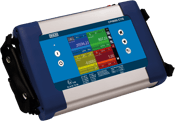If you're in the business of calibration, you probably have several high accuracy instruments that calibrate pressure, temperature, electrical, flow, level, and more. Wouldn't it be great if there was a single instrument that could handle multiple measurands?
Enter the multifunction calibrator. So why choose one for your application? The quick answer? Economy.
Economy is defined here as:- The frugal and efficient use of material resources
- The efficient and concise use of non-material resources
- An efficient arrangement and mode of operation
The economy of a multifunction portable calibrator will become apparent, but first some context:
Calibration involves a comparison of the output of a device under test (DUT) to a reference standard, and the correction to make the output align with the standard in a way that ensures its accuracy.
In industrial process systems, there are plenty of sensors used to measure and calibrate a variety of process variables, including pressure, temperature, flow and level. These physical properties are sensed and displayed locally or transmitted via a proportional electrical or digital signal. The signals can be monitored or used in a control scheme to transmit information back to control elements that affect the process. These control elements can be valves, thermostats, mechanical actuators, pumps, etc. The signals are transmitted using analog electrical signals such as milliamps (mA), millivolts (mV), volts (V) or ohms (Ω), frequency, and pulse, or digital, using a standard communication protocol.

A multifunction calibrator incorporates the ability to simulate the output signal of a variety of sensing elements in order to test and verify the DUT signal transmission. In addition to measuring and testing signal outputs, multifunction calibrators can generate the source element required, such as pressure, voltage, or current.
Efficient Use of a Multifunction Calibrator
Looking back at the definition of economy, a multifunction calibrator satisfies each definition:
A. The efficient use of material resources is achieved by using one instrument that is able to generate, simulate and measure many variables. A single instrument will be more economical and easier to manage than several instruments dedicated to a single task.
B. A concise use of non-material resources is achieved because the operation of a single instrument will be easier to learn and operate, eliminating the need for technicians to expend resources to learn multiple components.
C. The efficient mode of operation is achieved through the use of a single instrument with all-in-one functionality. The technician needs only to collect one calibrator to perform multiple calibrations in the field on many different sensors. Ease of use and the value of multifunction operation make the process more efficient.
For example, using one multifunction instrument to generate pressure, make a high accuracy measurement and calibrate the output of a DUT is more economical than purchasing a pressure pump, a pressure standard, and a volt-ohm meter (VOM). It is simply less expensive to purchase, learn and transport a single instrument as opposed to several.
An area where multifunction calibrators truly shine is for field use in power plants, oil and gas plants, chemical processing plants, etc. Typically, plants like these have a variety of instruments mounted on pipelines, on tanks or in other critical processes, where removing the device for testing or calibration is disruptive and detrimental. The ability to use portable multifunctional equipment for on-site needs will reduce downtime.  A good example of the kind of instrument that satisfies the efficiencies gained by using a portable multifunction calibrator is the WIKA CPH8000. It can measure and simulate gauge and absolute pressures, electrical signals (mA, mV, V, and Ω), temperature for thermocouples (TC) and resistance temperature devices (RTDs), frequency and pulse. In addition, it has an optional HART® module for communication with HART® instruments.
A good example of the kind of instrument that satisfies the efficiencies gained by using a portable multifunction calibrator is the WIKA CPH8000. It can measure and simulate gauge and absolute pressures, electrical signals (mA, mV, V, and Ω), temperature for thermocouples (TC) and resistance temperature devices (RTDs), frequency and pulse. In addition, it has an optional HART® module for communication with HART® instruments.
Conclusion
All in all, a portable multifunction calibrator makes the most sense for economical, efficient operations in process plants with a variety of sensing elements and process variables to measure and calibrate. It is cost efficient by performing the same number of tasks as if you were buying various pressure calibration items. If you want to find out more about multifunction calibrators, click the button below!
Related Reading:


